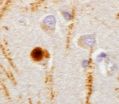(Press-News.org) PHILADELPHIA - Using powerful, newly developed cell culture and mouse models of sporadic Parkinson's disease (PD), a team of researchers from the Perelman School of Medicine at the University of Pennsylvania, has demonstrated that immunotherapy with specifically targeted antibodies may block the development and spread of PD pathology in the brain. By intercepting the distorted and misfolded alpha-synuclein (α-syn) proteins that enter and propagate in neurons, creating aggregates, the researchers prevented the development of pathology and also reversed some of the effects of already-existing disease. The α-syn clumps, called Lewy bodies, eventually kill affected neurons, which leads to clinical PD. Their work appears this week in Cell Reports.
Earlier studies by senior author Virginia M.Y. Lee, PhD, and her colleagues at Penn's Center for Neurodegenerative Disease Research (CNDR) had demonstrated a novel pathology of PD in which misfolded α-syn fibrils initiate and propagate Lewy bodies via cell-to-cell transmission. This was accomplished using synthetically created α-syn fibrils that allowed them to observe how Parkinson's pathology developed and spread in a mouse and in neurons in a dish. The present study is a proof-of-concept of how these models might be used to develop new PD therapies.
"Once we created these models, the first thing that came to mind is immunotherapy," says Lee, CNDR director and professor of Pathology and Laboratory Medicine. "If you can develop antibodies that would stop the spreading, you may have a way to at least retard the progression of PD." The current work, she explains, uses antibodies that were generated and characterized at CNDR previously to see if they would reduce the pathology both in cell culture and in animal models.
Lee's team focused on anti-α-syn monoclonal antibodies (MAbs). "In animal models," Lee explains, "the question we want to ask is, can we reduce the pathology and also rescue cell loss to improve the behavioral deficits?"
Using their previously established sporadic PD mouse model, the researchers conducted both prevention and intervention preclinical studies. For prevention studies, they injected mouse α-syn synthetic preformed fibrils into wild-type, normal mice, as a control, and then immediately treated the mice with Syn303, one of the MAbs used (or IgG , another type of common antibody, for the control mice).
The control group without MAb administration showed PD pathology in multiple brain areas over time, while the mice treated with Syn303 showed significantly reduced pathology in the same areas. For intervention studies, they treated PD mice with Syn303 several days after fibril injections when Lewy bodies were already present. They found that the progression of pathology was markedly reduced in the Syn303-treated mice versus mice that did not receive Syn303.
"But there are some limitations to experiments in live mice since it is difficult to directly study the mechanism of how it works," Lee says. "To do that, we went back to the cell culture model to ask whether or not the antibody basically prevents the uptake of misfolded α-syn." The cell culture experiments showed that MAbs prevented the uptake of misfolded α-syn fibrils by neurons and sharply reduced the recruitment of natural α-syn into new Lewy body aggregates.
Next steps for the team will be to refine the immunotherapeutic approach. "We need to make better antibodies that have high affinity for pathology and not the normal protein," says Lee.
The team's models also open up new opportunities for studying and treating PD. "The system really allows us to identify new targets for treating PD," Lee says. "The cell model could be a platform to look for small molecular drugs that would inhibit pathology." Their approach could also serve as a foundation for genetically based studies to identify specific genes involved in PD pathology.
"Hopefully more people will use the model to look for new targets or screen for treatments for PD. That would be terrific," concludes Lee.
INFORMATION:
The work was supported by an National Institute on Aging training grant (T32-AG000235), the National Institute of Neurological Disorders and Stroke Morris K. Udall Parkinson's Disease Center of Excellence (P50 NS053488), the Michael J. Fox Foundation, the Keefer family, and the Parkinson Council.
Coauthors, all from Penn are Hien T. Tran, Charlotte Hiu-Yan Chung, Michiyo Iba, Bin Zhang, John Q. Trojanowski, and Kelvin C. Luk.
Penn Medicine is one of the world's leading academic medical centers, dedicated to the related missions of medical education, biomedical research, and excellence in patient care. Penn Medicine consists of the Raymond and Ruth Perelman School of Medicine at the University of Pennsylvania (founded in 1765 as the nation's first medical school) and the University of Pennsylvania Health System, which together form a $4.3 billion enterprise.
The Perelman School of Medicine has been ranked among the top five medical schools in the United States for the past 17 years, according to U.S. News & World Report's survey of research-oriented medical schools. The School is consistently among the nation's top recipients of funding from the National Institutes of Health, with $392 million awarded in the 2013 fiscal year.
The University of Pennsylvania Health System's patient care facilities include: The Hospital of the University of Pennsylvania -- recognized as one of the nation's top "Honor Roll" hospitals by U.S. News & World Report; Penn Presbyterian Medical Center; Chester County Hospital; Penn Wissahickon Hospice; and Pennsylvania Hospital -- the nation's first hospital, founded in 1751. Additional affiliated inpatient care facilities and services throughout the Philadelphia region include Chestnut Hill Hospital and Good Shepherd Penn Partners, a partnership between Good Shepherd Rehabilitation Network and Penn Medicine.
Penn Medicine is committed to improving lives and health through a variety of community-based programs and activities. In fiscal year 2013, Penn Medicine provided $814 million to benefit our community.
Penn study describes new models for testing Parkinson's disease immune-based drugs
Understanding how disease spreads from neuron to neuron key to finding treatments
2014-06-12
ELSE PRESS RELEASES FROM THIS DATE:
Viral infections, including flu, could be inhibited by naturally occurring protein
2014-06-12
PITTSBURGH, June 12, 2014 – By boosting a protein that naturally exists in our cells, an international team of researchers led by the University of Pittsburgh Cancer Institute (UPCI), partner with UPMC CancerCenter, has found a potential way to enhance our ability to sense and inhibit viral infections.
The laboratory-based discovery, which could lead to more effective treatments for viruses ranging from hepatitis C to the flu, appears in the June 19 issue of the journal Immunity. The research is supported by the National Institutes of Health.
"Despite remarkable advances ...
African-Americans respond better to first-line diabetes drug than whites
2014-06-12
Washington, DC—African Americans taking the diabetes drug metformin saw greater improvements in their blood sugar control than white individuals who were prescribed the same medication, according to a new study published in the Endocrine Society's Journal of Clinical Endocrinology & Metabolism (JCEM).
An estimated 29 million Americans have diabetes. African Americans are twice as likely to be diagnosed with diabetes as whites and have a higher rate of complications such as kidney failure, according to the U.S. Department of Health and Human Services' Office of Minority ...
Brain power
2014-06-12
VIDEO:
Real-time movie of changes in total hemoglobin in the brain during stimulation. The initial blush of the brain is followed quickly by dilation (red) of arteries on the brain's surface....
Click here for more information.
New York, NY—June 12, 2014—In a new study published online in the Journal of the American Heart Association June 12, 2014, researchers at Columbia Engineering report that they have identified a new component of the biological mechanism that controls ...
Time-lapse study reveals bottlenecks in stem cell expansion
2014-06-12
A time-lapse study of human embryonic stems cells has identified bottlenecks restricting the formation of colonies, a discovery that could lead to improvement in their use in regenerative medicine.
Biologists at the University of Sheffield's Centre for Stem Cell Biology led by Professor Peter Andrews and engineers in the Complex Systems and Signal Processing Group led by Professor Daniel Coca studied human pluripotent stem cells, which are a potential source of cells for regenerative medicine because they have the ability to produce any cell type in the body.
However, ...
Synchronized brain waves enable rapid learning
2014-06-12
CAMBRIDGE, MA -- The human mind can rapidly absorb and analyze new information as it flits from thought to thought. These quickly changing brain states may be encoded by synchronization of brain waves across different brain regions, according to a new study from MIT neuroscientists.
The researchers found that as monkeys learn to categorize different patterns of dots, two brain areas involved in learning — the prefrontal cortex and the striatum — synchronize their brain waves to form new communication circuits.
"We're seeing direct evidence for the interactions between ...
Scientists find trigger to decode the genome
2014-06-12
Scientists from The University of Manchester have identified an important trigger that dictates how cells change their identity and gain specialised functions.
And the research, published today in Cell Reports, has brought them a step closer to being able to decode the genome.
The scientists have found out how embryonic stem cell fate is controlled which will lead to future research into how cells can be artificially manipulated.
Lead author Andrew Sharrocks, Professor in Molecular Biology at The University of Manchester, said: "Understanding how to manipulate cells ...
12 minutes of exercise improves attention, reading comprehension in low-income adolescents
2014-06-12
HANOVER, N.H. – June 12, 2014 – A new Dartmouth study Dartmouth study shows 12 minutes of exercise can improve attention and reading comprehension in low-income adolescents, suggesting that schools serving low-income populations should work brief bouts of exercise into their daily schedules.
The study, published as part of the June volume of Frontiers in Psychology, compared low-income adolescents with their high-income peers. While both groups saw improvement in selective visual attention up to 45 minutes after exercising, the low-income group experienced a bigger jump. ...
Opioid use prior to spine surgery linked to diminished patient reported outcomes
2014-06-12
ROSEMONT, Ill.─A new study appearing in the Journal of Bone and Joint Surgery (JBJS) links the use of opioid pain relievers (prescription medications, such as Percocet) to less improvement and higher levels of dissatisfaction following spine surgery.
Between 1999 and 2010, a greater focus on pain management resulted in a four-fold increase in opioids sold to hospitals, pharmacies and doctors' offices, and a related and ongoing increase in opioid-related complications, including opioid dependence, impaired cognition and poor treatment outcomes. Previous studies have ...
NASA and NOAA satellites analyze Category 4 Hurricane Cristina
2014-06-12
VIDEO:
On June 11, NASA's TRMM satellite found rain falling at a rate of over 74.4 mm/2.9 inches per hour in a strong feeder band east of Hurricane Cristina's eye.Another area...
Click here for more information.
A fleet of satellites from NASA and NOAA are on the job monitoring the first major hurricane of the Eastern Pacific Ocean Season as Hurricane Cristina has reached Category 4 status on the Saffir-Simpson scale.
This morning, June 12, at 1200 UTC (8 a.m. EDT), NOAA's GOES-West ...
Families like practical group wellness program -- and lose weight
2014-06-12
Seattle, WA—Many children are obese these days, but what can be done about it? Research-proven treatments for obesity exist, but they rely on regular one-on-one meetings with a trained health coach. So these "behavioral" treatments are seldom available outside of research studies in specialty medical centers.
It's feasible and acceptable to give this same kind of behavioral treatment to groups of families in primary care, Paula Lozano, MD, MPH, found. She published results of the Family Wellness Program in the Permanente Journal. She is a Group Health pediatrician and ...
LAST 30 PRESS RELEASES:
The Lancet: COVID-19 vaccine hesitancy decreased over time, though mistrust persists among certain groups, study of over 1 million people in England suggests
Psychosis patients ‘living in metaphor’ -- new study radically shifts ideas about delusions
Clinical trial in Ethiopia targets the trachoma scourge
Open-sourcing the future of food
Changes in genetic structure of yeast lead to disease-causing genomic instabilities
UC San Diego Health Sciences Grant Writing Course helps launch successful research careers
Study: Many head and neck cancer trials end early. Why?
Tufts vice provost for research named Foreign Fellow of Indian National Science Academy
New model improves prediction of prostate cancer death risk
Two wrongs make a right: how two damaging variants can restore health
Overlooked decline in grazing livestock brings risks and opportunities
Using rare sugars to address alcoholism
Research alert: New vulnerability identified in aggressive breast cancer
Ruth Harris honored with SSA Distinguished Service Award
Treasure trove of data on aging publicly accessible
Trees4Adapt project to address risks from climate change and biodiversity loss through tree-based solutions
Nature Communications study from the Lundquist Institute identifies molecular mechanism underlying peripartum cardiomyopathy
Pennington Biomedical’s Dr. Gang Hu appointed to NIH Reproductive, Perinatal and Pediatric Health Review Group
World-first project shows great promise to treat low eye pressure
New technique puts rendered fabric in the best light
Brain cancer digital twin predicts treatment outcomes
Cat disease challenges what scientists thought about coronaviruses
Paulson Family Foundation makes an additional $19 million donation to Hebrew University to fund a new building for electrical engineering. Together with its previous gift brings the total donation to
Canada–Estonia partnership advances community-centered clean energy
Sandia’s economic impact sets record for 17th consecutive year
Researchers uncover how tumors become resistant to promising p53-targeted therapy
Aligning games and sets in determining tennis matches
UOC research team develops method to evaluate apps for treating depression
Extreme heat waves disrupt honey bee thermoregulation and threaten colony survival
New brain study explains how binge drinking contributes to long-lasting negative feelings
[Press-News.org] Penn study describes new models for testing Parkinson's disease immune-based drugsUnderstanding how disease spreads from neuron to neuron key to finding treatments



